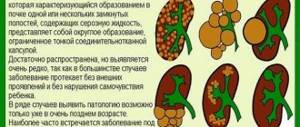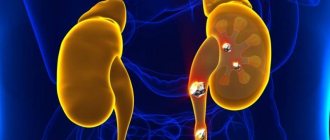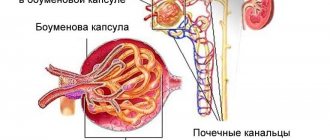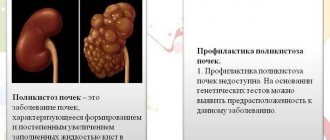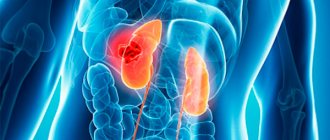Before starting treatment for glomerulonephritis, it is necessary to differentiate different variants of the disease, and if such a possibility exists, then perform a renal tissue biopsy on the patient. If the doctor knows the exact morphological picture of the processes occurring in the patient’s kidneys, then he will be able to choose the most rational treatment regimen.
Treatment of glomerulonephritis in the acute and chronic phases of the process has its own characteristics. The approach to treating patients is always combined. The main principle of treatment is to eliminate the main cause of the disease (if possible), as well as to influence all parts of the pathogenesis.
When the first symptoms of the disease appear (sudden swelling in the face, an unreasonable increase in blood pressure, nagging pain in the lower back on one or both sides, changes in urinary sediment, etc.), immediately consult a doctor and do not self-medicate. Only an experienced specialist knows how to treat glomerulonephritis and what doses of drugs should be used.
There are variants of the disease that cannot be cured forever, but thanks to modern approaches to the treatment of the process, it is possible to achieve stable remission in patients and stop the progression of the disease.
Treatment of acute diffuse glomerulonephritis
Patient management regimen
Any patient with this form of the process requires hospitalization in a department of the appropriate profile (therapeutic or nephrological). Until edema and high blood pressure are completely eliminated, he needs bed rest (for about 1.5-2 weeks). Thanks to this, the functioning of the glomerular apparatus of the kidneys improves, diuresis is restored, and the symptoms of insufficiency in the heart are eliminated.
After discharge, such patients are contraindicated in any physical work for two years, as well as staying in places with high temperatures (baths, saunas).
Medical nutrition
The principles of nutrition include the following requirements, only by observing which can you speed up the healing process:
- limit your consumption of foods containing large quantities of simple carbohydrates and protein;
- all food containing seasonings, spices and any other extractive components is completely excluded;
- the calorie content of the diet should not exceed the body’s daily energy needs, while its vitamin and mineral composition should be as balanced as possible;
- The volume of recommended fluid per day is calculated based on the patient’s daily urine output (400-500 ml is added to this figure, but no more, so as not to overload the kidneys).
It is necessary to limit your daily salt intake, all food should only be lightly salted (in the first week of treatment it is better to completely avoid salt)
Etiological treatment
If the role of a streptococcal agent in the occurrence of the process is proven, then adequate treatment of the disease begins with the prescription of antibiotics from the penicillin group. They are prescribed intramuscularly, the course of therapy lasts at least 10-14 days. When the situation requires it, treatment lasts longer.
The drug administration schedule is as follows:
- Penicillin 500,000 units intramuscularly 6 times a day (every 4 hours);
- Oxacillin 500 mg intramuscularly 4 times a day (every 6 hours).
Pathogenetic therapy
This section of treatment includes the use of drugs from a variety of pharmacological groups, due to which individual pathogenetic links of the disease are suppressed.
Treatment of patients with glomerulonephritis will be effective only if several groups of medications are prescribed at once.
Immunosuppressive therapy with hormonal agents is necessary to suppress autoimmune processes, eliminate the pronounced inflammatory component and stabilize the proteolytic activity of various enzyme systems in the patient’s body.
This group of drugs is used in the case of the nephrotic form of the process, when there is no pronounced hypertensive syndrome and a persistent increase in red blood cells in the patient’s urine. Also, the indication for their use is the onset of acute renal failure due to glomerulonephritis.
Prednisolone is used, the dosage of which is calculated based on the initial weight of the patient (1 mg/kg per day). The drug is taken at this dose for 1.5-2 months, after which the patient’s condition is assessed and the issue of gradually reducing the dose is decided, up to complete withdrawal (every 5-7 days it is reduced by 2.5-5 mg).
Immunosuppressive therapy with non-hormonal drugs (cytostatics) is an alternative to the previous group of drugs. The indication for its use is nephrotic syndrome, which is resistant to the action of hormones, or its combination with high blood pressure.
Most often, patients are prescribed Azathioprine at a dosage of 2-3 mg/kg or Cyclophosphamide 1.5-2 mg/kg per day for a period of 4 to 8 weeks. Then they switch to maintenance therapy, which is half of the previously taken dose. Its duration is at least six months.
Anticoagulants and antiplatelet agents reduce the permeability of the glomerular apparatus of the kidneys, inhibit the adhesion of platelets to each other and suppress blood clotting. In addition, they reduce the inflammatory component of the pathological process and improve the patient’s diuresis.
With glomerulonephritis there is a tendency to pathological blood clotting
I begin treatment of the patient with subcutaneous administration of Heparin 25,000-30,000 per day. The course of therapy lasts on average 6-8 weeks, if necessary it is extended to 4 months.
Among the antiplatelet agents, the most widely used is Curantil, which improves glomerular filtration rate and reduces blood pressure.
It is prescribed at a dose of 225-400 mg per day (for 6-8 weeks), then switches to maintenance treatment of 50-75 mg/day (from 6 months or more).
Nonsteroidal anti-inflammatory drugs have a positive effect in the fight against mediators of the inflammatory response and have a moderate anticoagulant and immunosuppressive effect.
The indication for prescribing drugs from this group is long-term proteinuria, in the absence of other clinical symptoms of the disease (swelling, pressure, decreased volume of daily urine excreted, etc.).
It is considered appropriate to use Ortofen at a dose of 75-150 mg/day for 4-8 weeks. It must be remembered that this drug can be prescribed only to patients who do not have problems with the gastrointestinal tract (gastritis, peptic ulcer and others).
Medical nutrition
Reduce the amount of table salt in your diet
Due to a disorder of the kidneys, a change in the water-electrolyte balance of the blood occurs. In this case, the body loses essential nutrients, while metabolic products and toxins accumulate in its tissues. Because of this, it is necessary to follow an adequate diet, which can reduce the negative effects on the human body associated with dysfunction of the renal apparatus due to glomerulonephritis. The most popular diet plan for such a disease is table number 7, the distinctive features of which are the following points:
Recommended topic:
Chronic glomerulonephritis
- reducing the amount of table salt in the diet;
- limiting fluid intake per day;
- eating foods enriched with potassium and calcium, but practically without sodium;
- reducing the amount of animal protein entering the body;
- introduction of increased amounts of vegetable fats and complex carbohydrates into the daily menu.
When using a different diet, you should follow the general recommendations, which are the same for any type of chronic glomerulonephritis. First of all, it is worth limiting (or completely eliminating) the intake of table salt, spicy, fried, smoked and salty foods, as well as alcoholic beverages. It is recommended to eat more foods rich in vitamins, and watermelon, melon, pumpkin and grapes are considered the most useful to eat. In cases where a person has proteinuria, it is necessary to increase the amount of protein in the diet.
Treatment of rapidly progressive glomerulonephritis
This form of the process is considered the most unfavorable, and the effectiveness of the therapy is low. This condition is treated with high doses of glucocorticoid hormones in combination with cytostatics (pulse therapy is used, often repeated after 2-3 days).
Non-drug therapy methods such as plasmapheresis and hemodialysis are widely used, the main task of which is to maximally cleanse the patient’s body of toxic substances accumulated in it and remove immune complexes.
In some cases, organ transplantation is resorted to, but the mortality rate among such patients remains extremely high.
Causes
The main reason for the development of glomerulonephritis is the presence of streptococcal infection in the body. Most often, the disease develops against the background of previous diseases:
- tonsillitis;
- pneumonia;
- tonsillitis;
- scarlet fever;
- streptoderma;
- measles;
- chicken pox;
- ARVI.
Prolonged exposure to cold and high humidity conditions can increase the likelihood of developing the disease, since these factors change the course of immune reactions and lead to disruption of the blood supply to the kidneys.
Glomerulonephritis may also be associated with viruses, including:
- toxoplasma;
- meningitis;
- staphylococcus and streptococcus.
Most often, the cause of the disease is nephritogenic strains of group A hemolytic streptococcus, which is confirmed by clinical studies. After scarlet fever, acute gormer nephritis is observed in 3-5% of children. The development of the disease is often caused by ARVI with concomitant chronic tonsillitis, and if the child is a carrier of cutaneous streptococcus.
Treatment of chronic glomerulonephritis
Patient management regimen
During the period of remission, all patients must avoid any hypothermia or overheating of the body, intense physical activity and overexertion. Work at night or in hot workshops is prohibited.
If the first symptoms of a cold appear, bed rest and adequate medical treatment with appropriate medications are recommended. During this period, the patient should be under medical supervision to prevent exacerbation of glomerulonephritis.
If the process nevertheless worsens, the patient is immediately hospitalized in a hospital, where he is prescribed the most gentle regimen (until he feels better).
Medical nutrition
The basic principles of nutrition in patients with chronic glomerulonephritis during an exacerbation are similar to those in patients with an acute process (described above).
If there is an isolated urinary syndrome (there are no symptoms of hypertension and edema), then moderate consumption of salt and seasonings that improve the taste of food (garlic, pepper and others) is allowed.
Etiological therapy
As a rule, such treatment is possible only in a small percentage of patients, since it is effective only in the early stages of the development of the process. The main principle of therapy is the timely sanitation of all foci of chronic infection in patients with chronic tonsillitis or endocarditis. For this purpose, penicillin antibiotics are used.
Treatment of the chronic form of the process with drugs is lifelong, that is, their complete abolition leads to relapse of the disease and deterioration of the patient’s well-being
Pathogenetic therapy
Standards of treatment for chronic glomerulonephritis are as follows.
Prescription of glucocorticoid hormones for nephrotic or latent form of the process, the duration of which does not exceed two years from the onset of the disease.
The greatest effectiveness of this group of drugs has been proven for glomerulonephritis with minimal changes, membranous and mesangioproliferative forms of the disease.
Prescribing Prednisolone at a dose of 1 mg/kg of the patient’s weight for a period of 4 to 8 weeks is considered optimal. The dosage is gradually reduced (2.5-5 mg every 2-3 days), reaching the optimal maintenance dose (it is individual for each patient).
If there is high disease activity, then pulse therapy is carried out with high doses of hormones, which are administered intravenously for 3 days (Methylprednisolone at a dose of 1000 mg once)
This group of drugs is contraindicated in the hypertensive form of the disease and its mixed version, as well as in the onset of renal failure.
Cytostatic therapy is indicated for all patients who have resistance to or intolerance to hormones, as well as hypertensive and mixed variants of glomerulonephritis. In such cases, they are prescribed in isolation, without the use of glucocorticoids.
If the patient has no contraindications for the combined treatment regimen (Prednisolone + cytostatic), then therapy is carried out with Azathioprine at a dose of 2-3 mg/kg of the patient’s weight or Cyclophosphamide 1.5-2 mg/kg for 8-10 weeks. Then they switch to maintenance doses (1/2 o or 1/3 of the initial ones).
Treatment of chronic and acute glomerulonephritis
Anticoagulants and antiplatelet agents are necessary to improve renal filtration processes and eliminate the processes of pathological thrombus formation (there is such a tendency).
In the hospital, patients begin subcutaneous administration of Heparin at 5000-10000 units every 6 hours for 6-8 weeks, after which the dosage is gradually reduced and the drug is discontinued.
In the future, Curantil 225-400 mg daily is used in therapy (10-12 months or more).
These medications are contraindicated in patients with a hematuric form of the disease and pathological processes in the gastrointestinal tract, as well as if the patient’s glomerular filtration level is less than 35 ml/minute.
NSAIDs are indicated for patients with a latent form of glomerulonephritis or with the nephrotic variant of the disease, when the patient has moderate proteinuria and erythrocyturia.
Indomethacin is prescribed at 50 mg/day, the dose of which is gradually increased to 150 mg daily. The average duration of treatment is 3-6 weeks, after which it is discontinued (the dosage is slowly reduced).
In severe cases of the process, patients undergo plasmapheresis (1-2 times a week), which significantly reduces the concentration of immune complexes and mediators of the inflammatory reaction in their blood
Symptomatic therapy
To relieve certain symptoms of the disease, medications from different pharmacological groups (hypotensives, diuretics, and others) are used. The choice of each of them is determined by the patient’s condition and the presence of certain symptoms.
Phytotherapy
Properly selected herbal infusions can have a good anti-inflammatory, hypotensive, diuretic, anticoagulant and detoxification effect.
In herbal treatment they use:
- infusion of birch leaves (2 tsp of dry substrate, pour 250-300 ml of boiling water, infuse and drink 4-5 times a day);
- decoction of lingonberry leaves (2 tablespoons of crushed leaves are placed in a special enamel bowl, add 200-250 ml, bring to a boil in a water bath, remove from the stove and let it brew, then drink half a glass 3 times a day);
- decoction of burdock root (10 g of crushed root is poured into 200 ml of boiling water, its further preparation and use is similar to the previous one).
Phytotherapy
Diuretic plants
Traditional medicine is rich in recipes related to the treatment of chronic glomerulonephritis, since people have long wanted to know how to effectively cure such a disease. The main role in them is played by plants, which have a pronounced diuretic effect on the human body. In addition, some of them have a powerful antibacterial effect (these include lingonberry, birch and angelica). Among the most useful vegetables and fruits that have the properties necessary for the treatment of chronic glomerulonephritis are watermelon, barberry, pear, melon, wild strawberry, white cabbage, gooseberry, and cranberry.
Also of great importance are medicinal plant herbs that can be used to treat chronic glomerulonephritis. One of the most popular recipes presented in traditional medicine is as follows:
- take 1 part of knotweed herb;
- 1.5 parts of lingonberry, birch and budra grass leaves;
- 2 parts calendula flowers;
- 2.5 parts of oat seeds and dried grass;
- 5 parts of rose hips and hawthorn;
- pour boiling water and leave at room temperature;
- Take the infusion one third of a glass three to four times a day half an hour before meals.
For the same purposes, a decoction of wild strawberry leaves, nettles, birch leaves and flax seeds, collected in a ratio of 1:1:2:5, can be used. This medicine must be taken 70-100 milliliters three to four times a day, as in the previous case, half an hour before meals.
Modern treatment regimen for glomerulonephritis
According to clinical recommendations, therapy for patients with glomerulonephritis should be combined and include several drugs from different pharmacological groups. There are many options for such schemes, the choice of each of them is determined by the patient’s condition. Below we will consider the most rational one.
The four-part treatment includes:
- Prednisolone at a dose of 1 mg/kg of patient weight per day.
- Cyclophosphamide at a dose of 2-3 mg/kg per day.
- Heparin at a dose of 20,000 units per day.
- Curantil at a dose of 400-600 mg per day.
All of the above drugs are taken for 6-8 weeks (longer if necessary), after which they are reduced to maintenance dosages.
Diagnostics
Glomerulonephritis, the diagnosis and treatment of which depends on the history and clinical picture, is a severe renal disease with a high risk of complications. For an accurate diagnosis, laboratory data is required. The following changes in tests are characteristic of glomerulonephritis:
- Hematuria (micro and macro). Change in urine to dark brown and black, the color of meat slop (macrohematuria). With microhematuria, urine does not change its natural color. A urine test performed in the first days of the disease may contain fresh red blood cells, but later in the tests they will be leached.
- Albuminuria. Within 2-3 weeks, protein is detected in the urine in moderate amounts (up to 6%).
- Microscopic examination of urinary sediment reveals hyaline and granular casts (microhematuria) or erythrocyte casts (macrohematuria).
- Nocturia. When performing the Zimnitsky test, a sharp decrease in diuresis (urine output) is observed. A high density of urinary fluid can confirm the preservation of the concentration function of the kidneys.
- A study of creatinine clearance indicates a decrease in the filtering function of the kidneys.
In the process of diagnosing glomerulonephritis, a general blood test is also performed, in which, in the presence of the disease, a significant increase in ESR and leukocytes is detected.
In a biochemical blood test, an increase in the volume of urea, creatinine, and cholesterol is observed. Elevated titers of AST and ASL-O and an increase in the amount of residual nitrogen (acute form of azotemia) may indicate the disease. Laboratory tests for glomerulonephritis are carried out regularly, monitoring the main indicators and adjusting the treatment regimen in accordance with them.
Spa treatment
The indication for referring a patient to sanatorium-resort treatment is the presence of residual effects of acute glomerulonephritis (for example, microscopic hematuria), as well as a chronic form of the disease in remission.
Patients are suitable for resorts with a dry and hot climate, due to which the process of sweating and elimination of nitrogen metabolic products is accelerated, and kidney function is improved. Such resort areas include: Yalta, Bayram-Ali and others.
A patient should never be sent for such treatment if he has symptoms of an acute process or severe hematuria.
Treatment in a sanatorium not only helps in the fight against the disease, but also improves the psycho-emotional state of the patient
The essence of the disease
Glomerulonephritis is a specific inflammatory disease of the kidneys of an immune nature. The renal glomeruli are predominantly affected, but often the disease also affects the renal tubules and interstitial tissue.
Pathology can occur either independently or against the background of systemic diseases such as vasculitis, lupus erythematosus, and infective endocarditis. The basis for the development of glomerulonephritis in most cases is an active immune response to the presence of antigens of infectious origin in the body. In some cases, glomerulonephritis develops in an autoimmune form, and then the destructive effect on the kidneys is due to the body producing antibodies not to its own cells.
The clinical picture of glomerulonephritis, the treatment of which is a very complex and lengthy process, is described as the deposition of antigenic antibodies in the capillaries of the glomeruli of the kidneys, which impede the process of blood flow and the production of primary urine. Against the background of the disease, water, salts and metabolic products are retained in the body, gradually leading to the development of renal failure and arterial hypertension.
Glomerulonephritis ranks second in prevalence among acquired kidney diseases, both in adult patients and in children (infectious diseases of the urinary tract are in first place). The disease often causes chronic renal failure and early disability.
Symptoms of the disease
Chronic glomerulonephritis is manifested by constantly high blood pressure and swelling; rarely, aching pain in the kidney area may occur.
- the appearance of blood in the urine;
- swelling of the face, feet and legs;
- high blood pressure;
- a sharp decrease in the daily dose of urine, while there is constant thirst;
- weight gain;
- dyspnea;
- general weakness, nausea, vomiting;
- headache;
- Sometimes the temperature may rise.
Symptoms of any form of glomerulonephritis can occur hidden. Decreased urination occurs due to impaired filtering function of the kidneys, and this already leads to edema.
The acute form of the disease can be manifested by severe pain in the lumbar region and the appearance of blood in the urine.
